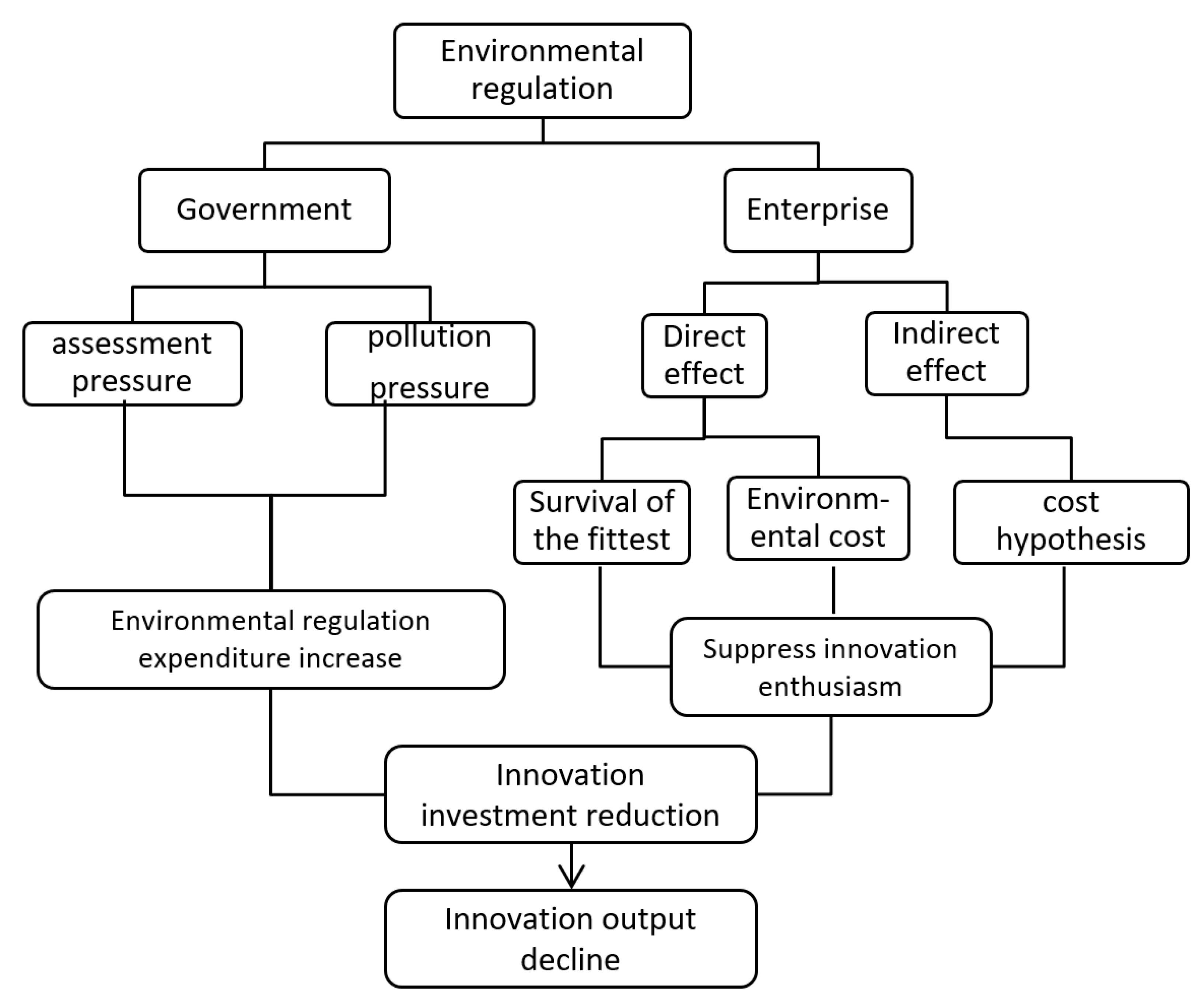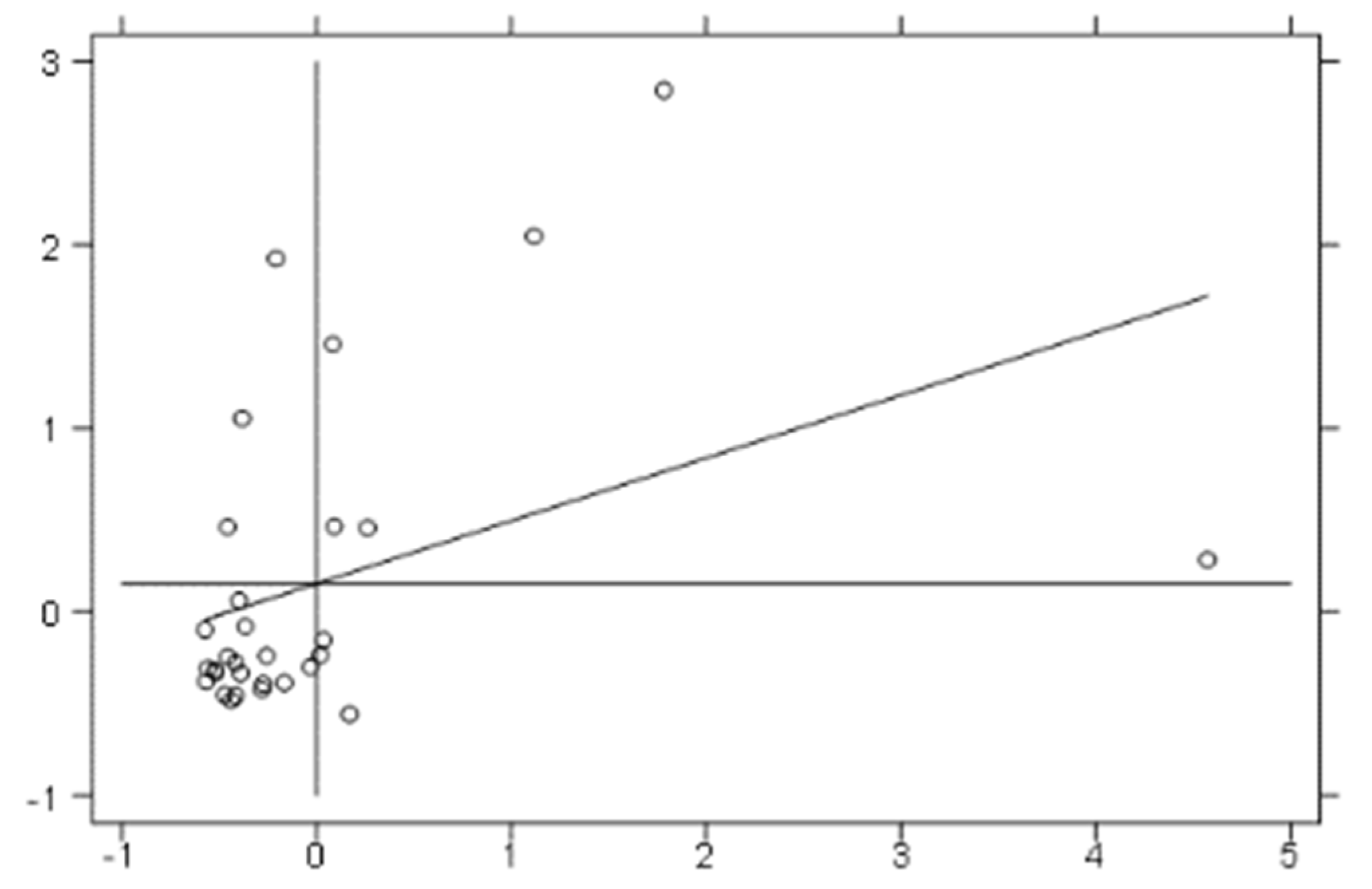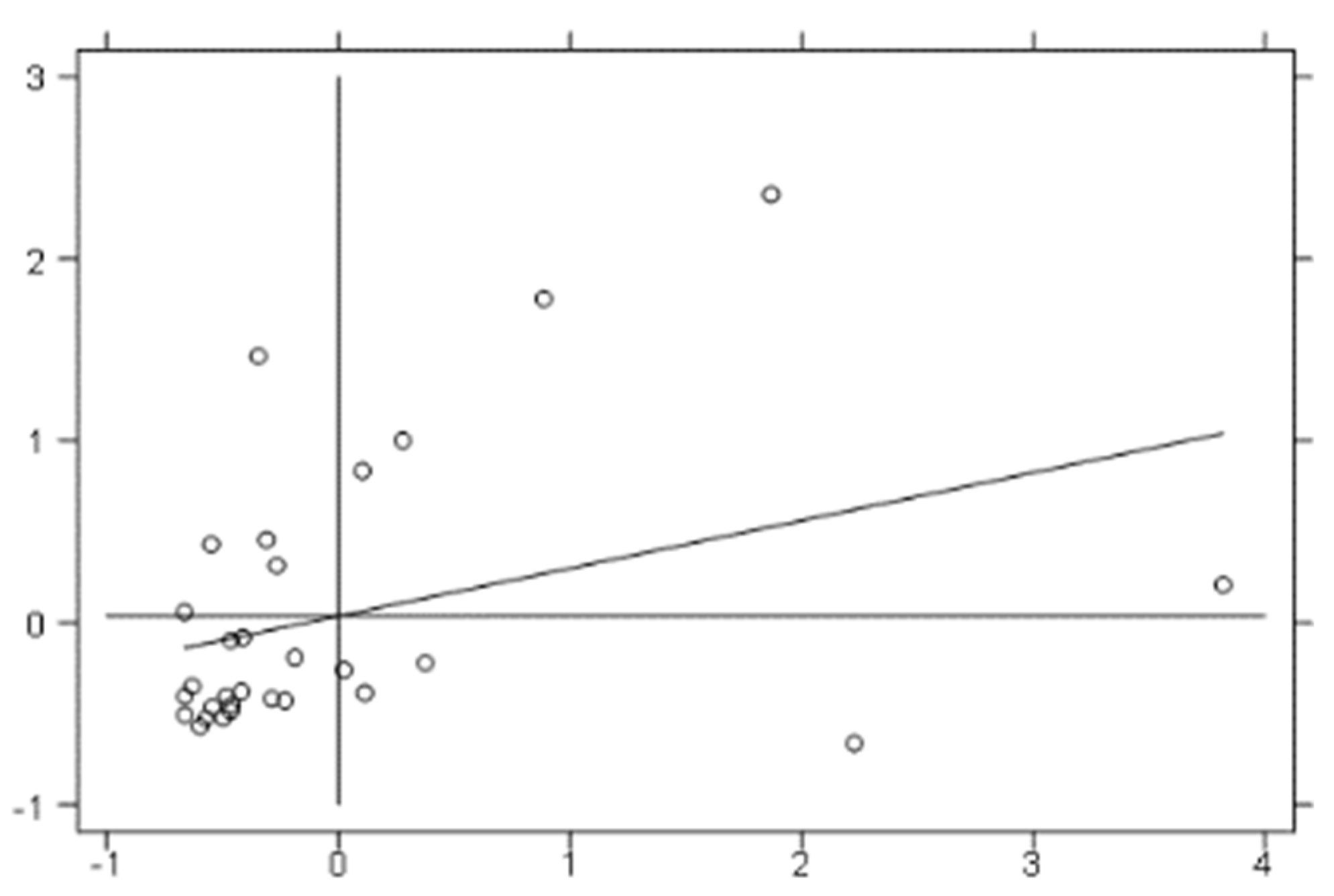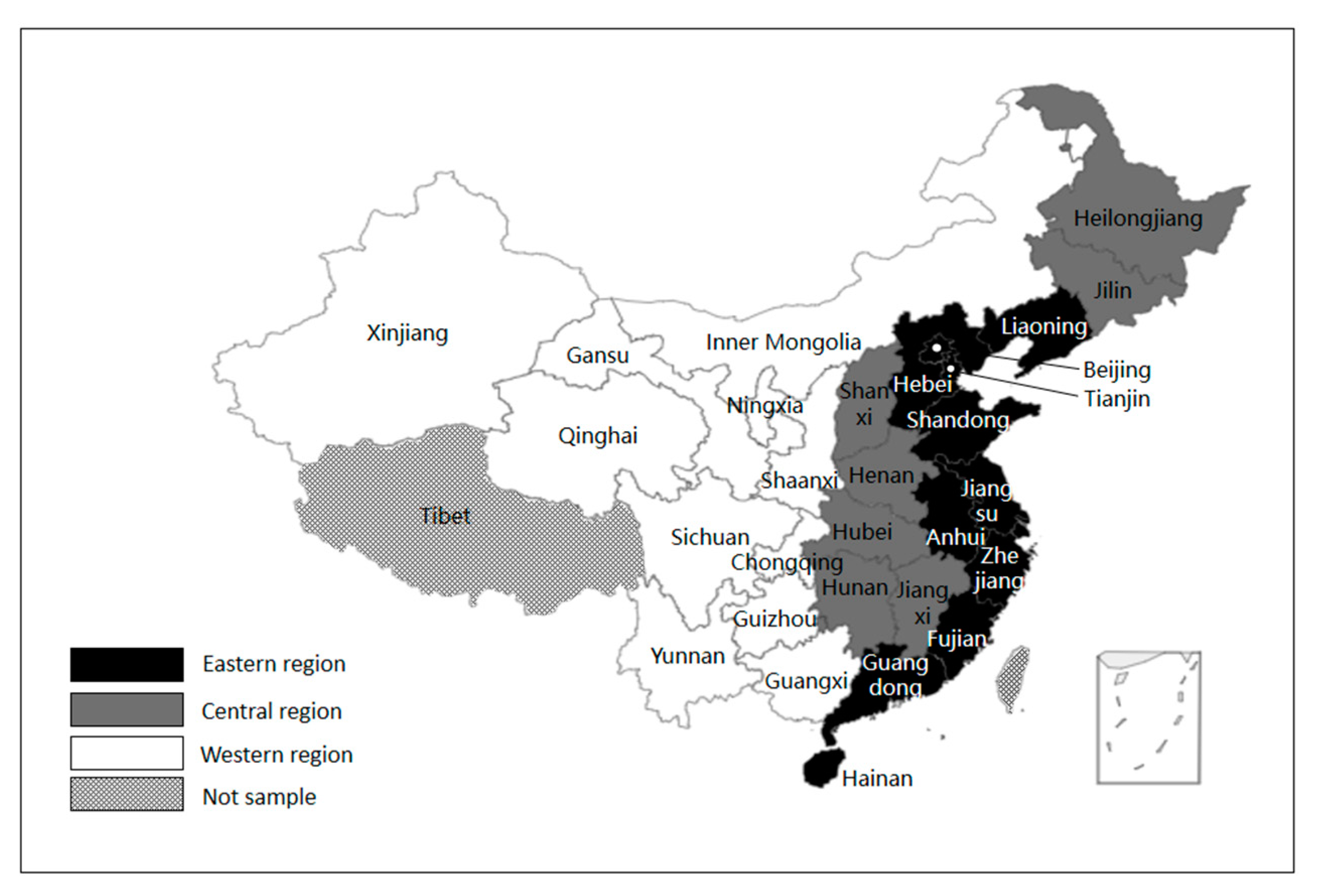Environmental Regulation and China’s Regional Innovation Output—Empirical Research Based on Spatial Durbin Model
Abstract
1. Introduction
2. Literature Review
3. Material and Methods
3.1. Theoretical Model
3.2. Model Building
3.3. Variables Measurement and Data Sources
4. Results and Discussion
4.1. Sample Description
4.2. Spatial Correlation Test
5. Spatial Econometrics Analysis
5.1. Model Selection
5.2. Estimated Results of the Spatial Econometric Model
5.3. Regional Tests
6. Conclusions
Author Contributions
Funding
Conflicts of Interest
References
- Chao, H.; Hu, H. How Does the Clean Production Standard Regulation Affect the Total Factor Productivity Dynamically? Excluding the Quasi-natural Experimental Analysis of other Policy Interferences. China Ind. Econ. 2015, 29, 70–82. [Google Scholar] [CrossRef]
- Popp, D.; Newell, R.G. Where Does Energy R&D Come From? Examining Crowding Out from Environmentally-Friendly R&D. Energy Econ. 2012, 34, 980–991. [Google Scholar]
- Jorgenson, D.W.; Wilcoxen, P.J. Environmental Regulation and U.S. Economic Growth. Rand J. Econ. 1990, 21, 314–340. [Google Scholar] [CrossRef]
- Rubashkina, Y.; Galeotti, M.; Verdolini, E. Environmental regulation and competitiveness: Empirical evidence on the Porter Hypothesis from European manufacturing sectors. Energy Policy 2015, 83, 288–300. [Google Scholar] [CrossRef]
- Zhu, X.; Zeng, A.; Zhong, M.; Huang, J.; Qu, H. Multiple impacts of environmental regulation on the steel industry in China: A recursive dynamic steel industry chain CGE analysis. J. Clean. Prod. 2019, 210, 490–504. [Google Scholar] [CrossRef]
- Levinson, A.; Taylor, M.S. Unmasking the Pollution Haven Effect. Int. Econ. Rev. 2010, 49, 223–254. [Google Scholar] [CrossRef]
- Cole, M.A.; Elliott, R.J.R. Determining the trade–environment composition effect: The role of capital, labor and environmental regulations. J. Environ. Econ. Manag. 2003, 46, 363–383. [Google Scholar] [CrossRef]
- Cole, M.A.; Elliott, R.J.R.; Okubo, T. Trade, environmental regulations and industrial mobility: An industry-level study of Japan. Discuss. Pap. 2010, 69, 1995–2002. [Google Scholar] [CrossRef]
- Porter, M.E.; Linde, C.V.D. Toward a New Conception of the Environment-Competitiveness Relationship. J. Econ. Perspect. 1995, 9, 97–118. [Google Scholar] [CrossRef]
- Lanoie, P.; Laurent-Lucchetti, J.; Johnstone, N.; Ambec, S. Environmental Policy, Innovation and Performance: New Insights on the Porter Hypothesis. J. Econ. Manag. Strategy 2011, 20, 803–842. [Google Scholar] [CrossRef]
- Li, X.; Lu, X.; Tao, X. Does the Intensity of Environmental Regulation Affect the Comparative Advantage of Trade in China’s Industrial Sector. J. World Econ. 2012, 34, 62–78. [Google Scholar]
- Tong, J.; Liu, W.; Xue, J. Environmental Regulation, Factor Input Structure and Industrial Transformation. Econ. Res. J. 2016, 51, 43–57. [Google Scholar]
- Wang, G. Cross-regional Synergetic Effect of Industrial Structure Change Under Environmental Regulation—Research Based on Spatial Durbin Model. Resour. Dev. Mark. 2019, 35, 889–895. [Google Scholar]
- Shi, H.; Yi, M. Research on Pareto Optimal Region of Win-win Environment Policy and Technological Innovation—The Empirical Analysis Based on Panel Data of 35 Industrial in China. Soft Sci. 2019, 33, 1–8. [Google Scholar] [CrossRef]
- Bu, M.; Liu, Z.; Wagner, M.; Yu, X. Corporate social responsibility and the pollution haven hypothesis: Evidence from multinationals’ investment decision in China. Asia-Pac. J. Account. Econ. 2013, 20, 85–99. [Google Scholar] [CrossRef]
- Zhao, S.L.; Cacciolatti, L.; Lee, S.H.; Song, W. Regional collaborations and indigenous innovation capabilities in China: A multivariate method for the analysis of regional innovation systems. Technol. Forecast. Soc. Chang. 2015, 94, 202–220. [Google Scholar] [CrossRef]
- Gao, W.; Cheng, J.; Zhang, J. The influence of heterogeneous environmental regulation on the green development of mining industry. China Popul. Resour. Environ. 2018, 28, 150–161. [Google Scholar]
- Chu, T. Study on the Impact of Environmental Regulation on Green Total Factor Productivity; Anhui University: Anhui, China, 2019. [Google Scholar]
- Wang, K.; Ji, X.; Xu, H. Financial Cluster, Property Rights Structure and Regional Innovation Performance—An Empirical Study Based on Chinese Provincial Panel Data. Explor. Financ. Theory 2018, 33, 41–50. [Google Scholar] [CrossRef]
- Gray, W.B.; Shadbegian, R.J. Environmental Regulation, Investment Timing, and Technology Choice. J. Ind. Econ. 1998, 46, 235–256. [Google Scholar] [CrossRef]
- Simpson, R.D.; Iii, R.L.B. Taxing Variable Cost: Environmental Regulation as Industrial Policy. J. Environ. Econ. Manag. 1996, 30, 282–300. [Google Scholar] [CrossRef]
- Tajeddini, K.; Trueman, M. Environment-Strategy and Alignment in a Restricted, Transitional Economy: Empirical Research on its Application to Iranian State-Owned Enterprises. Long Range Plan. 2016, 49, 570–583. [Google Scholar] [CrossRef]
- Lin, W. The Impact Mechanism of Environmental Regulation on Manufacturing Performance——Based on the Perspective of Local Government Competition. Sci. Technol. Manag. 2019, 1–10. [Google Scholar]
- Tobler, W.R. A Computer Movie Simulating Urban Growth in the Detroit Region. Econ. Geogr. 1970, 46 (Suppl. 1), 234–240. [Google Scholar] [CrossRef]
- Woods, N.D. Interstate Competition and Environmental Regulation: A Test of the Race-to-the-Bottom Thesis. Soc. Sci. Q. 2006, 87, 174–189. [Google Scholar] [CrossRef]
- Zhang, C.; Lu, W.; Guo, L.; Yu, T. The Intensity of Environmental Regulation and Technological Progress of Production. Econ. Res. J. 2011, 46, 113–124. [Google Scholar]
- Selden, T.M.; Song, D. Neoclassical Growth, the J Curve for Abatement, and the Inverted U Curve for Pollution. J. Environ. Econ. Manag. 1995, 29, 162–168. [Google Scholar] [CrossRef]
- Fan, W.; Wang, Y. Influence of environmental regulation intensity on regional technology innovation: An empirical research based on eastern and mid-China region. Ecol. Econ. 2016, 12, 43–51. [Google Scholar]
- Yang, Y.; Niu, G.; Tang, D.; Zhu, M.J. Does Environmental Regulation Affect the Introduction of Foreign Direct Investment China?—Empirical Research Based on the Spatial Durbin Model. Pol. J. Environ. Stud. 2019, 28, 415–424. [Google Scholar] [CrossRef]
- Liu, X.; Li, L.; Ge, J.; Tang, D.L.; Zhao, S.Q. Spatial Spillover Effects of Environmental Regulations on China’s Haze Pollution Based on Static and Dynamic Spatial Panel Data Models. Pol. J. Environ. Stud. 2019, 28, 2231–2241. [Google Scholar] [CrossRef]
- Hu, C.; Zhao, S. Knowledge Spillovers Absorption of Provincial Districts in China—An Empirical Research Based on Spatial Econometrics. Forum Sci. Technol. China 2011, 27, 79–84. [Google Scholar] [CrossRef]
- Grossman, G.M.; Helpman, E. Innovation and Growth in the Global Economy; MIT Press: Cambridge, MA, USA, 1991; pp. 122–130. [Google Scholar]
- Li, J.; He, Y.I. Study of Knowledge Spillover Effect on Regional Innovation Performance from the Perspective of Spatial Correlation—Based on Provincial Data Samples. RD Manag. 2017, 29, 42–54. [Google Scholar]
- Breusch, T.S.; Pagan, A.R. The Lagrange Multiplier Test and its Applications to Model Specification in Econometrics. Rev. Econ. Stud. 1980, 47, 239–253. [Google Scholar] [CrossRef]
- Dunbar, C.G.; Li, Z.F.; Shi, Y. Corporate Social Responsibility and CEO Risk-Taking Incentives; Social Science Electronic Publishing: Rochester, NY, USA, 2016. [Google Scholar]
- Lesage, J.; Pace, R.K. Introduction to Spatial Econometrics, 1st ed.; CRC Press: Boca Raton, FL, USA, 2009. [Google Scholar]
- Elhorst, P.J. Matlab Software for Spatial Panels. Int. Reg. Sci. Rev. 2014, 37, 389–405. [Google Scholar] [CrossRef]
- Wang, Y.D.; Wang, D. Porter hypothesis, environmental regulation and technological innovation in enterprises—A comparative analysis of the central and eastern regions. China Soft Sci. 2011, 1, 100–112. [Google Scholar]
- Zhao, X.; Sun, B. The influence of Chinese environmental regulation on corporation innovation and competitiveness. J. Clean. Prod. 2015, 112, 1528–1536. [Google Scholar] [CrossRef]







| Year | RCP | ERS | ||
|---|---|---|---|---|
| Moran’s I | p-Value | Moran’s I | p-Value | |
| 2006 | 0.263 | 0.004 | 2.855 | 0.002 |
| 2007 | 0.273 | 0.005 | 1.955 | 0.025 |
| 2008 | 0.286 | 0.006 | 2.041 | 0.021 |
| 2009 | 0.264 | 0.023 | 2.331 | 0.010 |
| 2010 | 0.251 | 0.031 | 2.255 | 0.012 |
| 2011 | 0.183 | 0.027 | 2.642 | 0.004 |
| 2012 | 0.187 | 0.014 | 2.550 | 0.005 |
| 2013 | 0.194 | 0.024 | 2.517 | 0.006 |
| 2014 | 0.195 | 0.033 | 2.334 | 0.010 |
| 2015 | 0.200 | 0.034 | 2.590 | 0.005 |
| 2016 | 0.194 | 0.038 | 2.453 | 0.007 |
| Spatial Durbin Model | Ordinary Panel Model | ||||
|---|---|---|---|---|---|
| Independent Variable | Spatial Fixed Effects | Time-Period Fixed Effects | S and T Fixed Effects | Individual Fixation Effect | Two-Way Fixed Effect |
| ERS | −1.718 *** (−6.77) | −1.4592 *** (−6.40) | −1.6944 *** (−6.47) | −1.237 *** (−3.50) | −2.3203 *** (−9.53) |
| FDI | −0.000385 ** (−2.38) | −0.0004061 *** (−3.37) | −0.000401 ** (−2.32) | −0.000448 *** (−5.41) | −0.00049 ** (−2.94) |
| RIC | 0.0006283 *** (8.02) | 0.000547 *** (7.34) | 0.0006581 *** (8.03) | 0.00038 *** (3.30) | 0.000617 *** (6.53) |
| RHC | 3.4012 ** (1.97) | 4.58904 *** (2.83) | 3.03736 * (1.81) | 4.7478 *** (3.65) | 0.3598 (0.16) |
| RAI | 0.61343 ** (2.27) | 0.63757 ** (2.28) | 0.5727 ** (1.96) | 1.9169 *** (3.51) | 0.6163 * (1.82) |
| GOV | 12.95564 ** (2.13) | 9.9774 * (0.091) | 13.6025 ** (2.22) | 3.66134 (0.93) | 9.9445 * (1.84) |
| W*RCP | 0.40925 *** (2.04) | 0.42162 *** (7.00) | 0.35677 *** (5.49) | — | — |
| W*ERS | 0.6633 (0.72) | 0.84613 (1.02) | 0.42032 (0.44) | — | — |
| W*FDI | 0.0007129 *** (4.000) | 0.000840 *** (6.42) | 0.00068 *** (3.28) | — | — |
| W*RIC | 0.0002167(1.52) | 0.000184 (1.37) | 0.000361 ** (2.14) | — | — |
| W*RHC | −3.4636 * (−1.73) | −3.6776 * (−1.77) | −5.612 * (−1.74) | — | — |
| W*RAI | −0.3369 (−0.60) | −0.5167 (−0.93) | −0.3921 (−0.54) | — | — |
| W*GOV | −24.7409 * (−2.05) | −22.1116 ** (−1.99) | −21.548 * (−2.04) | — | — |
| Constant | — | — | — | −50.4153 *** (−5.47) | −14.329 (−0.76) |
| Log-L | −1004.4939 | −1081.8313 | −1010.9708 | — | |
| R2 | 0.5821 | 0.5721 | 0.5651 | 0.3152 | 0.5612 |
| Direct Effects | Coefficient | t | p | Indirect Effects | Coefficient | t | p |
|---|---|---|---|---|---|---|---|
| ERS | −1.7142 | −5.87 | 0.000 | ERS | −0.07062 | −0.05 | 0.963 |
| FDI | −0.000329 | −2.04 | 0.042 | FDI | 0.000894 | 3.21 | 0.001 |
| RIC | 0.000675 | 8.38 | 0.000 | RIC | 0.000736 | 3.76 | 0.000 |
| RHC | 3.17485 | 1.97 | 0.049 | RHC | −3.4980 | −1.25 | 0.211 |
| RAI | 0.6362 | 2.36 | 0.018 | RAI | −0.06457 | −0.08 | 0.940 |
| GOV | 10.9385 | 1.85 | 0.064 | GOV | −30.762 | −1.67 | 0.095 |
| Regional | W*RCP | ERS | W*ERS | Direct Effects | Indirect Effects | R2 | Log-L |
|---|---|---|---|---|---|---|---|
| Eastern Region | 0.1217 ** (1.15) | −1.6882 *** (−10.65) | −0.5192 (−1.47) | −1.7170 *** (−10.65) | −0.7906 ** (−2.36) | 0.8497 | −327.7573 |
| Central Region | 0.3690 *** (4.57) | −2.0886 (0.322) | 7.9967 *** (2.66) | −2.0419 (−0.60) | 6.2381 (1.06) | 0.6851 | −228.0180 |
| Western Region | 0.3248 *** (2.90) | −7.4365 *** (−3.15) | −2.8220 (−0.62) | −7.4687 *** (−2.79) | −0.6259 (−0.09) | 0.6256 | −369.666 |
© 2019 by the authors. Licensee MDPI, Basel, Switzerland. This article is an open access article distributed under the terms and conditions of the Creative Commons Attribution (CC BY) license (http://creativecommons.org/licenses/by/4.0/).
Share and Cite
Li, Y.; Tang, Y.; Wang, K.; Zhao, Q. Environmental Regulation and China’s Regional Innovation Output—Empirical Research Based on Spatial Durbin Model. Sustainability 2019, 11, 5602. https://doi.org/10.3390/su11205602
Li Y, Tang Y, Wang K, Zhao Q. Environmental Regulation and China’s Regional Innovation Output—Empirical Research Based on Spatial Durbin Model. Sustainability. 2019; 11(20):5602. https://doi.org/10.3390/su11205602
Chicago/Turabian StyleLi, Yun, Yingkai Tang, Kun Wang, and Qiwei Zhao. 2019. "Environmental Regulation and China’s Regional Innovation Output—Empirical Research Based on Spatial Durbin Model" Sustainability 11, no. 20: 5602. https://doi.org/10.3390/su11205602
APA StyleLi, Y., Tang, Y., Wang, K., & Zhao, Q. (2019). Environmental Regulation and China’s Regional Innovation Output—Empirical Research Based on Spatial Durbin Model. Sustainability, 11(20), 5602. https://doi.org/10.3390/su11205602






